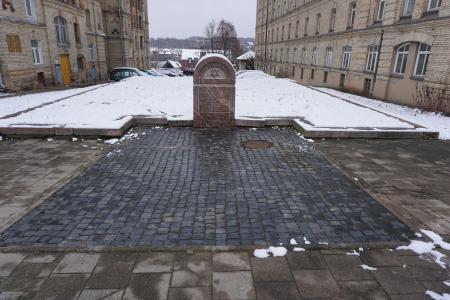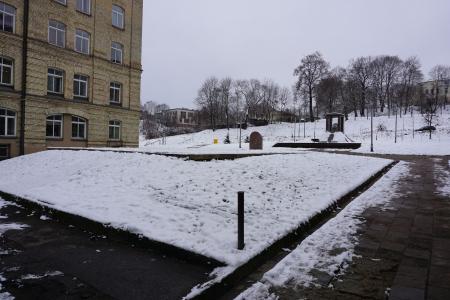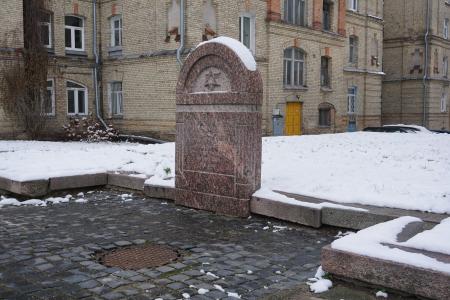Obj. ID: 45485
Modern Jewish Art Symbolic tombstone at the Cheap Houses in Vilnius, Lithuania, 1993
To the main object: Cheap Houses in Vilnius, Lithuania

Who is Commemorated?
Jewish workers of the HKP forced labor camp who were killed on July 4, 1944.
Description
The monument is located between the two buildings known as the Cheap Houses, at the southern section of the plaza. It is a granite, round-headed stele in the form of a traditional tombstone, with a carved Star of David on its upper portion. A Hebrew inscription is placed in the middle of the stele, flanked by stylized columns. A plot in front of the stele is paved with cobblestones, while a framed plot behind it symbolizes a mass grave.
Stones for the border of the grave are Jewish tombstones from the Užupis cemetery, which were used for building purposes in the city in the 1960s and removed in the early 1990s. (Vilna yerushalayim de-lita hareva 1993, p. 27)
Plaques explaining the history of the HPK are attached to the western building nearby. A monument to Jewish workers of the HKP forced labor camp is located in front of this symbolic grave.
Inscription:
In Hebrew:
בחצר זו מחנה הכפייה ה.ק.פ.
נרצחו ע"י המרצחים הגרמנים
ועוזריהם המקומיים
כ-400 אנשים, נשים וטף יהודיים
ונקברו פה בבורות
ביום י"ג בתמוז תש"ד 4.7.1944
השם יקום דמם
ת.נ.צ.ב.ה.
Translation: In this courtyard of the forced labor camp HKP / were killed by the German murderers / and their local aides / about 400 Jewish men, women and children / and buried here in pits / on 13 Tammuz 5704 July 4, 1944 / God will avenge their blood / May their souls be bound in the bundle of life.
Commissioned by
Yeshayahu (Shaya) Epstein
sub-set tree:
The Cheap Houses were built in 1897-1898 in order to provide affordable and hygienic housing for poor Vilnius Jews.
With the German occupation in 1941, their Jewish dwellers were driven to their murders in Ponary or resettled in the ghetto. The two buildings were converted into a camp for the wives and children of Red Army officers who stayed in the city when the Red Army retreated from the city. By the autumn 1943, some of these women had been killed in Ponary and others were sent for forced labor in Germany, while the children were sent to orphanages. A plaque in memory of those women and children was affixed to the eastern building (49 Subačiaus St.) in the early 2000s.
In late August and early September 1943, the buildings were converted into an army vehicles repair shop known as The HKP (Heereskraftfahrpark Ost 562), and a labor camp for Jews working there. The idea to create a separate camp for Jewish workers was came from Major Karl Plagge, a German Officer and the head of HKP (he would later be named as one of the Righteous Among the Nations in 2004). After the annihilation of the ghetto, the camp also housed the wives, children and sometimes parents of the workers. In November 1943, there were 1,218 registered inmates and in March 1944 there were 1,257.
On March 27, 1944, a children’s Aktion was conducted, during which all children under the age of 16 were seized. According to some sources, the children were transferred to death camps in Poland, while according to others they were killed in Vilnius and buried in the Third Jewish cemetery.
On July 1, 1944, Plagge announced that the HKP was to be relocated because of the approaching Red Army, and indirectly warned the prisoners about a planned murder. On July 3, 1944, those who were not hiding were sent to Ponary. On July 4, 1944, SS men undertook a search of the building, and the around 200 discovered Jews were shot immediately near the buildings. On July 9, the Red Army arrived to the camp and those who had not been found – about 150-200 people – were set free.
After the war, the buildings were used by the Soviets as a camp for German POWs.
The monument was erected on the initiative of Yeshayahu Epstein and funded by the members of the "Nusah Vilna" organization in New York.
There is, however, a discrepancy about the unveiling date of the monument. According to Guzenberg 2013 (p. 60), the tombstone was erected in 1992 on the initiative of Yeshayahu Epstein and funded by donations from Israel and the USA. According to Guzenberg 2021 (p. 602) and Agranovskii 2014 (p. 201), tombstone was erected in 1991. The correct date, however, is July 13, 1993, and this monument was unveiled together with a larger monument and the plaques nearby.
Agranovskii, Genrikh. Oni zdes’ zhili... Zametki o evreiskom nasledii Vilniusa (Vilnius: Versus Aureus, 2014)., 201.
Agranovskii, Genrikh and Irina Guzenberg. Vilnius: Po sledam Litovskogo Ierusalima. Pamiatnye mesta ereiskoi istorii i kul’tury, 2nd ed. (Vilnius: The Vilna Gaon Jewish State Museum, 2016)., 588.
Guzenberg, Irina, Vilnius: Sites of Jewish Memory. A Concise Guide. Second revised and supplemented edition. Trans. Svetlana Shatalova (Vilnius: Pavilniai Publishers, 2019)., 62-63.
Guzenberg, Irina, Vilnius: Traces of the Jewish Jerusalem of Lithuania. Memorable Sites of Jewish History and Culture. A Guidebook (Vilnius: Pavilniai, 2021)., 594-602.
Guzenberg, Irina, Žydų darbo stovykla HKP, 1943–1944: Dokumentai – Еврейский рабочий лагерь Х.К.П., 1943–1944: Документы – The H.K.P. Jewish Labor Camp, 1943–1944: Documents (Vilnius: The Vilna Gaon Jewish State Museum, 2002).
Guzenberg, Irina. Vilnius: Pamiatnye mesta evreiskoi istorii i kul'tury (Vilnius: Pavilniai, 2013)., 60.
Holocaust Atlas of Lithuania, THE HKP JEWISH LABOR CAMP, http://www.holocaustatlas.lt/EN/#a_atlas/search//page/1/item/120/., http://www.holocaustatlas.lt/EN/ (accessed December 20, 2022)
Itzhak Alfasi (ed.), Vilna yerushalayim de-lita hareva! haita ve-einena od (Tel Aviv, 1993), 24-27.
Jakulytė-Vasil, Milda. Lithuanian Holocaust Atlas (Vilnius: VIlna Gaon State Jewish Museum, 2011), 298-299.
Levinson, Yosif, Skausmo knyga. The Book of Sorrow. Dos bukh fun veytik. Sefer ha-keev (Vilnius: VAGA Publishers, 1997)., 48-49.














